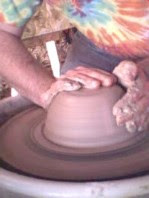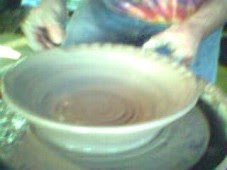Vibrant Days….
Flourishing with Sensory Processing Sensitivity
March 2019
I have been experimenting with art lately and finding it calming and satisfying. (and trust me focusing on the process not the outcome.)
HANDS ON FOR HSPS
Too often we highly sensitive people spend more time inside our own minds than in our bodies. What do I mean by this? Dwelling inside our own minds in reflection, contemplation, or as a protective mechanism (shielding us from overstimulation or negative stimulation) are in the realm of the intangible. We have nothing to show for our mental gymnastics if we do not convert that into a physical reality. Making things with our hands is the key and we have moved far away from what is such a natural human capacity in our modern, technological world.
One of the prime factors mentioned by so many HSPs that I have spoken with over the years has been a need for meaningfulness; to know that their efforts had a real impact in the lives of others. I was just conferring with a consulting client yesterday when the observation was made as to the essentially meaningless nature of her work in retail. Yes, having things available for people to buy (especially necessary things) is useful and productive overall but is not especially meaningful in the sense of deriving meaningfulness from having made something out of nothing. This same client actually has a side gig where she creates short films using a painstaking process of claymation, which entails hand-sculpting the figures and sets only to take one single photo before moving each figure a tiny fraction and taking another photo (think frames on a film reel). Claymation takes a huge amount of time, effort, and focus to produce even a few minutes of film. The result, though is a “real” manifestation of her work (and the resultant satisfaction that goes with it).
Anothe r example is wheel-thrown pottery, which I am intimately familiar with as I taught myself to “throw” at a local community college studio and, later, bought my own studio setup. Throwing pottery on a wheel is the ultimate example of mind and body working together in perfect sync to produce not only an object that is useful (a bowl or a cup) but also beautiful. In one of my former lives (and I have not thrown in many years) I was quite good at throwing pots that came from somew
r example is wheel-thrown pottery, which I am intimately familiar with as I taught myself to “throw” at a local community college studio and, later, bought my own studio setup. Throwing pottery on a wheel is the ultimate example of mind and body working together in perfect sync to produce not only an object that is useful (a bowl or a cup) but also beautiful. In one of my former lives (and I have not thrown in many years) I was quite good at throwing pots that came from somew here deep inside my own mind as well as embodied practical uses (a mug shape for instance). Clay is the most wonderfully malleable material one could work with to create real objects of utility and art. Moreover, working to develop an adequate cross-over from the abstract part of the brain that just thinks about how to do a movement to including the parts that actually control movement yields tremendous benefits in self-confidence and self-esteem. Like many other processes and techniques, the more you practice the better you get (or as my kids well know, the “p” word).
here deep inside my own mind as well as embodied practical uses (a mug shape for instance). Clay is the most wonderfully malleable material one could work with to create real objects of utility and art. Moreover, working to develop an adequate cross-over from the abstract part of the brain that just thinks about how to do a movement to including the parts that actually control movement yields tremendous benefits in self-confidence and self-esteem. Like many other processes and techniques, the more you practice the better you get (or as my kids well know, the “p” word).
If it’s been awhile si nce you’ve made anything with your two hands I highly encourage you to consider digging in and making something! Talent only counts a small fraction; it’s hard work and practice that brings technique and refinement. Let yourself play, explore, and take a few risks. In our modern world of endless electronic jibber-jabber we have forgotten what it means to be human, to be creative, and to use the wonderfully complex and capable devices at the end of our arms (our hands) in conjunction with our minds.
nce you’ve made anything with your two hands I highly encourage you to consider digging in and making something! Talent only counts a small fraction; it’s hard work and practice that brings technique and refinement. Let yourself play, explore, and take a few risks. In our modern world of endless electronic jibber-jabber we have forgotten what it means to be human, to be creative, and to use the wonderfully complex and capable devices at the end of our arms (our hands) in conjunction with our minds.
Over the five decades of my life I have learned to do many things with my hands (and mind). I’ve dug in the soil to grow plants, learned every phase of building a home as I constructed my own log home, and delved deep into the fine arts as a painter, a potter, and a sketcher. There is no end to what you can build with your hands or what you can create. Some things you can build are entirely useful and necessary (a home or a garden) while others are beautiful and feed our souls (paintings, pottery, decorating a home or yard).
When it comes to things I appreciate the most it always distills down to the handmade. I do appreciate machine-made objects for their symmetry and precision but the handmade quality of a thing where one can see the effort and time put into its creation is beyond compare. I invite you to begin noticing the beauty in the handmade because everything that is produced by hand requires creative and critical thinking working in symbiosis to make a reality out of the abstract. Developing a working relationship and appreciation of the necessity of creative and critical thinking combined with a physical embodiment of what we are capable of making, or doing, with our hands puts us more in touch with who we are and what we are built for as humans.
Want to be fully engaged? Go build something…
It is taking me a lifetime to find tender and restorative responses to overwhelm. Love this truth “how we are relating to what is happening” has powerful repercussions.
https://onbeing.org/blog/sharo
